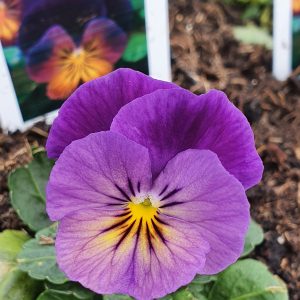Viola, commonly known as pansies or violets, are charming and colourful flowering plants that thrive in cool weather. Follow this comprehensive planting guide to ensure successful establishment and abundant blooms of your Viola plants.
Choose the Right Location
Sun Exposure: Violas prefer partial to full sun. In warmer climates, partial shade in the afternoon helps protect them from excessive heat.
Well-Drained Soil: Plant Violas in well-drained, fertile soil with a slightly acidic to neutral pH.
Planting Time
Autumn or Early Spring: Violas thrive in cool weather. Plant them in the autumn for winter and early spring blooms or in early spring for a burst of colour.
Spacing
Adequate Spacing: Space Viola plants 6 to 8 inches apart. This ensures proper airflow, prevents overcrowding, and promotes healthy growth.
Planting Depth
Proper Depth: Plant Violas at the same depth they were in the nursery containers. Ensure the crown is at or slightly above the soil level.
Watering
Consistent Moisture: Keep the soil consistently moist, especially during dry spells. Violas prefer evenly moist soil but avoid waterlogged conditions.
Mulching: Apply a layer of mulch around the plants to retain moisture, regulate soil temperature, and suppress weeds.
Fertilisation
Balanced Fertiliser: Use a balanced, all-purpose fertiliser at planting time. For established plants, feed them with a slow-release fertiliser in early spring.
Deadheading
Regular Removal of Spent Blooms: Deadhead faded flowers regularly to encourage continuous blooming and maintain a tidy appearance.
Pest and Disease Management
Vigilant Monitoring: Regularly inspect plants for pests like aphids or snails. Treat infestations promptly with insecticidal soap or organic remedies.
Good Air Circulation: Proper spacing and adequate ventilation help prevent fungal diseases. Avoid overhead watering.
Pruning
Trimming Leggy Growth: If Violas become leggy, trim back the stems by a third. This encourages bushier growth and more flower production.
Winter Care
Cold Protection: In colder climates, provide extra mulch around the base of Violas to protect them during winter. Container-grown Violas may need additional insulation.
Observation and Adjustments
Regular Inspection: Keep an eye on your Viola plants throughout the growing season. Adjust care practices based on observations of their health and performance.
By following this planting guide, you can establish and maintain healthy and vibrant Viola plants, bringing a burst of colour to your garden during the cooler seasons.
















